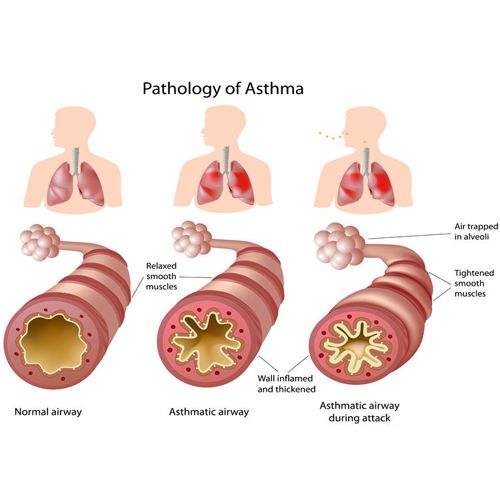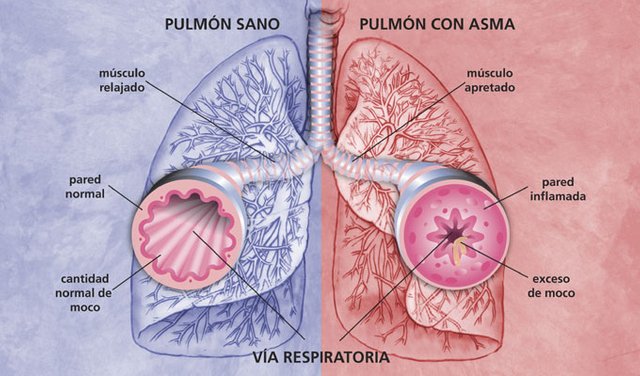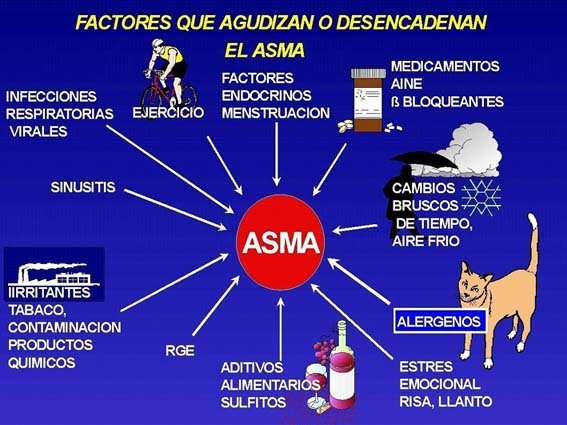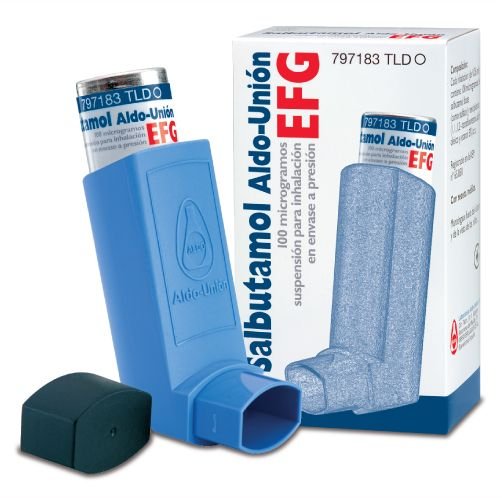Definition
Asthma is a chronic respiratory disease with an inflammatory basis and unknown etiology. In these patients the airway is sensitive to multiple irritant stimuli and is reversible spontaneously or with treatment. It is a disease of high prevalence: 2-6% of the population. Usually with prolonged cough, shortness of breath, wheezing and sensation of chest tightness.

Diagnosis
It is based on the history of recurrent respiratory symptoms, reversible airway obstruction, especially by spirometry and exclusion of other alternative diagnoses.
Interrogation
In the less than 5 years the diagnosis should be by exclusion of other pathologies that cause wheezing before the impossibility To perform expirometric tests

History
Family history of: bronchial asthma. 2. Personal history of: rhinitis or atopic dermatitis diagnosed by the physician. 3. Episodes of wheezing: at least three or more in the last year and more than 24 hours in duration. (Its absence does not exclude the diagnosis). 4. Nighttime symptoms: presence of cough or breathlessness at night that disrupts sleep. Recurrent dyspnea. 6. Recurrent retroexternal pain or pain
Appearance of symptoms in association with some of the following specific factors
1.Dust or environmental chemicals. 2. Dandruff or animal hair. 3. Time changes. 4. Physical exercise. 5. Homemade octopus. 6. Pollen from plants. 7. Cigarette smoke. 8. Viral infections. 9. Night aggravation of symptoms. 10. Strong Emotional Expressions
Complementary
expirometric tests. High peripheral blood eosinophil counts. Nasal cytology. Test of skin sensitivity to allergens. Rx of the thorax. Others deemed advisable in doubtful cases.

Differential diagnosis of asthma. The family doctor should know the entities with which asthma can be confused and include the following
In the adult: 1. COPD. 2. Heart failure. 3. Cough secondary to drugs (ACEI). 4. Laryngeal dysfunction. Foreign bodies or tumors of the airway. 6. Pulmonary embolism. 7. Eosinophilic pulmonary infiltration. 8. Dysfunction of the vocal cords.
Children: High Respiratory Tract 1. Allergic rhinitis. 2. Sinusitis.
Aims of treatment - avoid death - restore the patient to the best possible level of activity - maintain optimal respiratory function - prevent relapse through anti-inflammatory treatment

Treatment of the asthma crisis in children
The treatment of the acute crisis can be staggered according to the intensity of the crisis. In cases of mild crisis, treatment should be performed under the control of the physician and family nurse, either at the office level or at the home level, provided that family members have sufficient training

Inhaled salbutamol treatment (outline).
Salbutamol inhaled (with spacer and mask in very small children and in infants): 2-4 inh. C / 20 min. During the 1st hour of the mild 4-8 inh crisis. C / 20 min. During the 1st hour in moderate and severe seizures
Salbutamol in nebulization: 0.01 mg./Kg. (Maximum 5 mg.) 0.5% nebulizer solution Oxygenation of 5 to 6 liters / min should be taken into account.
If a good response is obtained: - normal respiratory rate, non-dyspnea, PEF> 80%. It is recommended to continue with outpatient treatment: Salbutamol for 3 to 4 hours and restart the usual inter-crisis prophylactic treatment used by the patient. You must attend the doctor's office, 24 hours after the acute crisis, to follow their evolution.
If incomplete response is obtained: - normal or increased respiratory rate, moderate dyspnea, mild intercostal impression, PEF 50-80%. A new cycle is recommended with Salbutamol and the early administration of corticosteroids, oral prednisone, 1-2 mg. / Kg. / Day (max 40 mg.) Of 3-7 days. If the answer is incomplete or bad, you should assess your transfer to the hospital emergency department.
If a poor response is obtained: - increased respiratory rate (> 60 / min) Major dyspnea, intercostal and suprasternal tracings, nasal flutter, cyanosis, PEF <50%. If you are in the health area (family doctor's office, in the police force), your immediate transfer to a pediatric hospital emergency department should be assessed.

Thank you very much to all
Thanxs op info (👍)
Downvoting a post can decrease pending rewards and make it less visible. Common reasons:
Submit
Thank you
Downvoting a post can decrease pending rewards and make it less visible. Common reasons:
Submit
Congratulations @supremacia3! You have received a personal award!
Click on the badge to view your Board of Honor.
Do not miss the last post from @steemitboard:
SteemitBoard World Cup Contest - The results, the winners and the prizes
Downvoting a post can decrease pending rewards and make it less visible. Common reasons:
Submit
Congratulations @supremacia3! You received a personal award!
You can view your badges on your Steem Board and compare to others on the Steem Ranking
Vote for @Steemitboard as a witness to get one more award and increased upvotes!
Downvoting a post can decrease pending rewards and make it less visible. Common reasons:
Submit
Congratulations @supremacia3! You received a personal award!
You can view your badges on your Steem Board and compare to others on the Steem Ranking
Do not miss the last post from @steemitboard:
Vote for @Steemitboard as a witness to get one more award and increased upvotes!
Downvoting a post can decrease pending rewards and make it less visible. Common reasons:
Submit